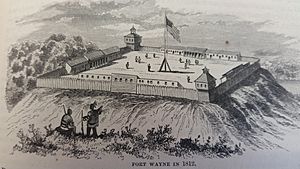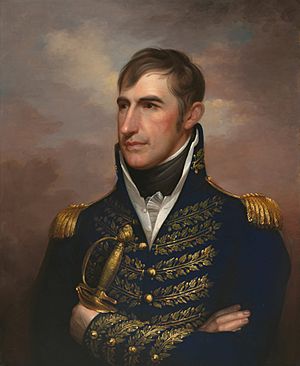Siege of Fort Wayne facts for kids
Quick facts for kids Siege of Fort Wayne |
|||||||
|---|---|---|---|---|---|---|---|
| Part of the War of 1812 | |||||||
 Fort Wayne |
|||||||
|
|||||||
| Belligerents | |||||||
| Miami Potawatomi |
|||||||
| Commanders and leaders | |||||||
| Chief Winamac Chief Wannangsea |
James Rhea, Philip Ostander, William Henry Harrison |
||||||
| Strength | |||||||
| 500 warriors | 100 (garrison) 3,000 (relief force) |
||||||
| Casualties and losses | |||||||
| about 25 killed | Hundreds | ||||||
The siege of Fort Wayne took place from September 5th-12th, 1812, during the War of 1812. The standoff occurred in the modern city of Fort Wayne, Indiana, between the United States garrison at Fort Wayne and a combined force of Potawatomi and Miami, supported by British troops. The conflict began on September 5, when warriors under Native American chiefs Winamac and Five Medals killed two members of the U.S. garrison. Over the next several days, the Native Americans burned the buildings and crops of the fort's adjacent village, and launched sporadic assaults from outside the fort. Winamac withdrew on 12 September, ahead of reinforcements led by Major General William Henry Harrison.
The attack on Fort Wayne was one of several attacks on U.S. outposts by Native Americans in September 1812. Other coordinated attacks occurred at Fort Harrison, Pigeon Roost, and Fort Madison.
Contents
Background
Fort Wayne was established in 1794 by United States forces under Major General Anthony Wayne. It was built at the end of the Northwest Indian War to exert United States influence at a large collection of Native American towns known as Kekionga. The 1809 Treaty of Fort Wayne, which granted approximately 30 million acres of Native American land to white settlers in the areas of Illinois and Indiana, was a major influence behind the Native American motivation to resist the United States' expansion. In addition, the 1811 Battle of Tippecanoe kept tensions high between native nations and U.S. settlers.
Fort Wayne, in North-East Indiana Territory, had fallen into disrepair in the years leading up to 1812. It was a frontier outpost stationed in a busy Native American town. The garrison was often insubordinate, many of the buildings deteriorated and supplies dwindled under the leadership of Captain James Rhea. The garrison first learned of the fall of Fort Dearborn on 26 August, when Corporal Walter Jordan returned after escaping the massacre. On 28 August, Stephen Johnston, a local trader, was killed approximately a mile from the fort. This news created disquiet in the garrison, and Indian agent John Johnston sent Shawnee Captain Logan to help evacuate the local women and children to the neighbouring state of Ohio, 20 miles to the east.
In September 1812, warriors from the Potawatomi and Miami nations, led by Chiefs Winamac and Five Medals, gathered around Fort Wayne, garrisoned by approximately 70 soldiers and some civilians. Captain James Rhea sent letters to John Johnston and Ohio Governor Return Meigs to ask for assistance. On several occasions Rhea invited Indian delegates into the fort to discuss terms of peace with the Indians. Historian Milo M. Quafie maintains news of the siege had been relayed “to Picqua, Ohio by Stephen Ruddle, whence his message was conveyed to Harrison".
Siege
Siege
On the morning of September 5, 1812, the siege began when Chief Winamac's forces attacked two soldiers returning from an outhouse. The Native Americans assaulted the fort from the east side and burned the homes of the surrounding village. The Indians constructed two wooden cannons with the intention of convincing the US garrison that the British had arrived with artillery.
Captain Rhea retreated to his quarters on the grounds that he was ill. The fort's Indian Agent, Benjamin Stickney, was recovering from an illness, but took command of the fort with Lieutenants Daniel Curtis and Phillip Ostrander. Two assaults were made on the fort before the Native American force withdrew, awaiting a British force on the Maumee River that was bringing light artillery. That evening, Chief Winamac approached the fort with thirteen of his men to parley and was admitted. As the leaders talked, Winamac revealed a knife that he had hidden, and after a failed attempt on Stickney's life, Winamac was removed from the fort. Soon after, at approximately 8:00pm, the Native American forces resumed their assaults on the exterior of the fort. Winamac's forces tried to set the fort on fire, and while the garrison tried to keep the walls wet, they returned fire with muskets and howitzers. The battle lasted until approximately 3:00 in the afternoon on 6 September, when the Native American forces retired to a safe distance from the fort. The fighting resumed at 9:00 that night.
Relief

Efforts were already underway to reinforce Fort Wayne after news of the loss of Fort Michilimackinac, Fort Dearborn, and Fort Detroit reached Newport Barracks. General James Winchester was commander of the Northwestern Army, but Kentucky Governor Charles Scott had recently appointed Indiana Territory Governor William Henry Harrison as Major General of the Kentucky Militia and authorized him to relieve Fort Wayne, and Harrison was at Newport Barracks to assume command of the militia. Harrison wrote a letter to Secretary of War William Eustis explaining the situation and apologizing for taking unauthorized action, then quickly organized a militia force of 2,200 men and marched North to the fort. A small scouting party led by Fort Wayne settler William Oliver and Ohio Shawnee Captain Logan arrived at Fort Wayne during a lull in the fighting, eluding Winamac's army and entering the fort. They delivered the news that a relief effort was approaching, and again rode through Winamac's siege to report to Harrison that the fort remained under U.S. control.
Harrison also received a report that a force of 400 Native Americans and 140 British regulars under Tecumseh were marching towards Fort Wayne. Harrison raced to arrive at Fort Wayne before Tecumseh and the British. By 8 September, Harrison and his backup of 2,200 troops had reached the village of Simon Girty on the St. Marys River, and was joined by 800 men of the Ohio militia under Colonel Adams and Colonel Hawkins at Shane's Crossing.
On September 11, Winamac attempted a final attack on Fort Wayne, proving unsuccessful. On 12 September, the attack was broken off, and Winamac's forces crossed the Maumee River and disappeared into the woods. Harrison's relief army arrived later that day, uncontested by Winamac's warriors. The Native American and British force retreated into Ohio and Michigan Territory.
After the British had successfully captured the city of Detroit, they had received the news that American Indians had surrounded an American Fort. General Isaac Brock learned that a temporary armistice had been made in the east, and ordered Colonel Henry Procter to withhold support for the attack on Fort Wayne.
Aftermath
The siege of Fort Wayne prompted Harrison to order punitive expeditions against nearby Native American villages. He sent a detachment of 17th Infantry Regiment and mounted rifles under Colonel Samuel Wells against the Potawatomi villages of Five Medals, and another detachment of two Kentucky regiments under Brigadier General John Payne against Miami villages at the forks of the Wabash. The punitive expeditions culminated in the Battle of the Mississinewa in December 1812. Influential Miami Chief Pacanne had remained neutral in this latest war, but following American retaliation for the Fort Dearborn Massacre, Pacanne openly aligned with the British.
The unsuccessful attempts to take Fort Harrison and Fort Wayne, as well as the reprisals by Harrison, caused many Native Americans to lose confidence. Many of them turned instead to the influential leadership of Tecumseh and joined his confederacy. No major Indian attacks occurred in the Indiana Territory for the rest of the war, but it was not until Tecumseh's defeat at the Battle of the Thames that the Native American pressure on United States settlers waned.
On 18 September 1812, while the detachments were away attacking villages, General Winchester arrived at Fort Wayne. Harrison relinquished command and later received orders from Secretary Eustis to regain control of Michigan Territory. Harrison's successes built his reputation, and he soon replaced Winchester as commander of the North West Army. He planned to use Fort Wayne as one staging ground in an attempt to retake Fort Detroit, leading to the Battle of Frenchtown four months later.
Three active battalions of the current 3rd Infantry (1-3 Infantry, 2-3 Infantry and 4-3 Infantry) continue the lineage of the old 1st Infantry Regiment, which had a detachment at Fort Wayne. Following the destruction of the Council house during the siege, the building was reconstructed on the same site in 1816.


